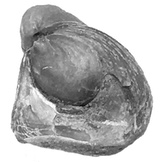Graduate Studies
Our graduate students in stratigraphy and stratigraphic paleontology study a range of problems mostly centered on some aspect of sequence stratigraphy and its application to paleontologic problems. Some test particular claims of the sequence stratigraphic paradigm, such as the correlatability and synchroneity of surfaces. Others apply sequence principles to particular field problems. Recent work emphasizes the relationships between sequence stratigraphic architecture and many aspects of paleontology, including morphometrics, biostratigraphy, and paleoecology. Students with interests in combining paleontology and stratigraphy are highly encouraged to apply. The Stratigraphy Lab emphasizes field work, the pursuit of outside funding for their research, and the publication of research.
My advising style is hands-on: I generally meet with each of my students for half an hour to one hour every week, and we have an informal lab meeting every week. I have an open-door policy and encourage students to stop by when they have questions. We also try to have a Stratigraphy Lab field trip at least once a year, plus movie nights every semester. We strive to keep a positive lab environment, and diversity is important.
Graduate Research in Progress
Cade Orchard, M.S., expected Spring 2024. Stratigraphic architecture and the fossil record of the Cretaceous Cloverly Formation, Wyoming.
Emily Jackson, M.S., expected Spring 2025.
Completed Graduate Dissertations and Theses
Marjie Cone, M.S., 2023. Testing for climate and elevation controls on Pennsylvanian plant communities in valley fills of the Breathitt Group in Eastern Kentucky.
Elliot Blake, M.S., 2022. Thesis: Controls on the occurrence of vertebrate tracks in the Jurassic Gypsum Spring and Sundance Formations, Bighorn Basin, U.S.A.
Max Deckman, M.S., 2022. Thesis: A reinterpretation of the Triassic Crow Mountain and Popo Agie Formations as a distributive fluvial system, Wind River Basin, Wyoming.
Samantha Khatri, M.S., 2022. Thesis: Sequence-stratigraphic controls on the occurrence of dinosaur fossils in the Hell Creek Formation.
Anik Regan, M.S., 2021. Thesis: Sequence-stratigraphic control on the nonmarine fossil record: a test in the Judith River Formation of north-central Montana.
Sydney Lee, M.S., 2020. Thesis: Testing two paleogeographic interpretations of the Jurassic of western North America.
Garett Brown, Ph.D., 2020. Dissertation: Beyond water depth: the environmental controls on marine benthic invertebrate assemblages in the modern and fossil record.
Pedro Monarrez, Ph.D., 2019. Dissertation: Testing the role of escalation on Jurassic macroevolutionary patterns.
Matt Hess, M.S., 2019. Thesis: Sequence-stratigraphic architecture and facies of the Middle to Upper Jurassic Preuss and Stump formations.
Sierra Swenson, M.S., 2019. Thesis: Integrated sequence stratigraphy and paleobiology of the Ellis Group of Montana: implications for the history and communities of the Sundance Seaway.
Sarah Wright, M.S., 2017. The falling-stage progradation of an open-coast tidal flat: UAV-assisted sequence stratigraphy of the Jurassic Windy Hill Sandstone, Wyoming.
Bolton Howes, M.S., 2017. Sequence Stratigraphic Expression of Flexural Subsidence: Middle Jurassic Twin Creek Limestone, Wyoming, U.S.A.
Annaka Clement, M.S., 2015: The sequence stratigraphy of the Middle Jurassic Gypsum Spring and Piper Formations in the eastern Bighorn Basin of Wyoming, U.S.A.
Kris Kusnerik, M.S., 2015: Community paleoecology and biogeography of the Jurassic (Bajocian–Oxfordian) Sundance Seaway in the Bighorn Basin of Wyoming and Montana, U.S.A.
Chris Ginn, M.S., 2014: Sequence stratigraphy of the Silurian Clinch Formation, northeastern Tennessee and southwestern Virginia.
Chelsea Jenkins, M.S., 2014: Are biogeographic provinces discrete or gradational: a test in the Late Ordovician of Laurentia.
Judi Sclafani, M.S., 2013: Testing the relationship of metacommunity area and Hubbell’s theta in the Late Ordovician of Laurentia.
Ally Platsky, M.S., 2013: Testing the stability of Hubbell’s over multiple time scales of eustatic perturbations.
Sharon McMullen, M.S., 2012: The occurrence of vertebrate and invertebrate fossils in a sequence stratigraphic context: The Jurassic Sundance Formation, Bighorn Basin, Wyoming, USA.
Max Christie, M.S., 2011: Contrasting the ecological and taxonomic intensity of extinction.
Andrew Zaffos, M.S., 2010: Abundance and extinction at the Ordovician/Silurian boundary of the Cincinnati Arch, USA.
Noel Heim, Ph.D., 2008: Community assembly and assessing the role of dispersal in creating local, regional, and global diversity: a case study of the middle Carboniferous of the eastern Great Basin and the Ozarks, USA.
Karen Layou, Ph.D., 2007: Biotic recovery from a regional extinction event: the Late Ordovician of the Appalachian Basin of the eastern United States.
Jessica Allen, M.S., 2003: Sequence stratigraphic and facies analysis of the Harding Sandstone: implications for the habitat of some of the earliest fish.
Gayle Levy, M.S., 2002: Morphologic change and sequence architecture in the brachiopod Sowerbyella rugosa: Upper Ordovician, Cincinnati, Ohio area.
Dan Hunter, M.S., 2000: Testing for subaerial exposure at Upper Ordovician sequence boundaries, Nashville, Tennessee.
Andrew Benson, M.S., 1998: The marine carbon and oxygen isotopic record during the M3-M5 transition in the southern Appalachians.
Alan Peoples, M.S., 1997: Marginal marine parasequences in the Cretaceous Dakota Group, Canon City Embayment, Colorado.
John Jordan, M.S., 1997: Sequence stratigraphy of a carbonate to siliciclastic transition: the Mississippian / Pennsylvanian boundary interval of eastern Tennessee.
Polly Bouker, M.S., 1996: Quantitative testing of storm bed proximality gradients, Silurian Red Mountain Formation, Ringgold Gap, Georgia.
Applications and More Information
For more information on graduate studies, contact me:
Steven Holland
Department of Geology
The University of Georgia
Athens, GA 30602–2501
stratum@uga.edu

